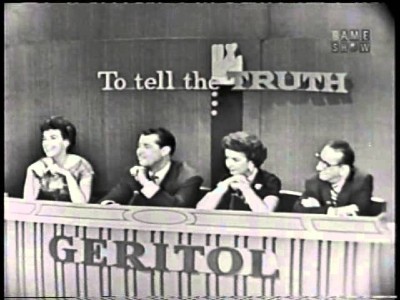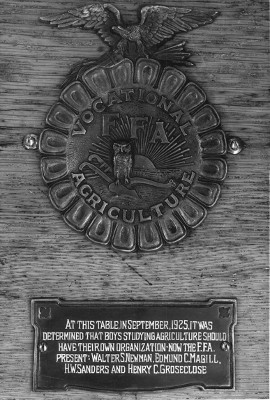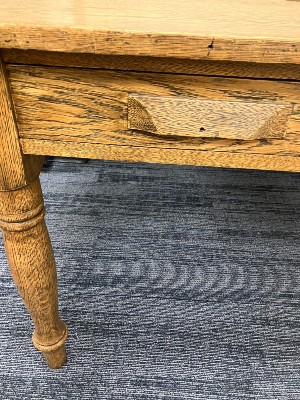Between 1956 and 1976 there was a television show “To Tell the Truth”. Three individuals would all claim to be a specific person who had done something noteworthy such as being the Father of the FFA. The four celebrity panelists would then ask questions to try and determine which of the three was the true Father of the FFA. After the voting was done by the panelists, the show’s host would then say” Will the real Father of the FFA please stand up?” That is the idea behind this Footnote. We are searching for the Father of the FFA.

Figure 1. Panelists on To Tell the Truth
During the past several weeks the Friday Footnotes have focused on the founding fathers of various agricultural organizations and disciplines. That effort will continue this week. We are going to describe how the Future Farmers of America (FFA) was started and then let you vote on who is (are) the father(s) of the FFA.
Note: In this Footnote Virginia Polytechnic Institute (VPI) and Virginia Tech will be used frequently. The institution was known as VPI up until 1970 when it was accorded university status. It then became Virginia Polytechnic Institute and State University. The official nickname is Virginia Tech.
The Founding of the Future Farmers of America
Who made this statement and where was it made?
“In my opinion the farm boys of Virginia who are enrolled in vocational agriculture are equal to any other group of boys in the state. But somehow the boys themselves seem to have a feeling of inferiority. Especially is this true when the farm boy goes to the city and has to compete with his city cousin. This condition should not exist. I believe that a strong organization of our boys in agriculture would help them to overcome this handicap. Let’s form an organization that will give them a greater opportunity for self-expression and for the development of leadership. In this way they will develop confidence in their own ability and pride in the fact that they are farm boys.”
September 1925
The above statement was made in September of 1925 by the newly appointed state supervisor of Agricultural Education in Virginia. His name – Walter S. Newman.
Newman assumed the state supervisor position on September 1, 1925. Previously he taught agriculture at Windsor High School in Virginia and had been an associate professor of agricultural education at VPI since 1922.
A few weeks after becoming the state supervisor Newman went to VPI to meet with his former colleagues, the teacher education faculty – Edmund C. Magill (the head of the department), Harry Sanders (a faculty member), and Henry Groseclose (itinerant teacher educator). It was at this meeting that Newman made the above statement (Noblin, 1942; Sanders, 1953; Bryant, 2001).

Figure 2. This plaque is found on the desk at Virginia Tech where this historical meeting was held.
At this meeting Henry Groseclose, by common consent, was assigned the responsibility for developing a plan for the proposed student organization (Noblin, 1942). Groseclose was literally the new kid on the block. He had previously taught agriculture at Buckingham High School and joined the VPI faculty in 1924. As an itinerant teacher trainer, Henry was responsible for traveling across the state working with new agriculture teachers – basically, he was teaching agriculture teachers how to teach while on the job.
There was one other person at this meeting – James O. Hoge. Jim was the agriculture teacher at Rural Retreat High School and had come to campus to find the answer to a subject matter question posed by a resident of his community. While on campus he decided to stop by the Agricultural Education Building and visit the department (Jim’s sister was married to Walter Newman). He was invited to sit in on this historic meeting. Hoge recalled his reaction to the meeting (Hoge, July 18, 1963. p. 2):
Being just a young teacher, I was very nervous at that meeting. I was so nervous, in fact, I pulled out my penknife and carved a hole in the desk drawer. Years later, when looking for that table because of its historical value to the FFA, I identified it by that hole I had carved.

Figure 3. The small hole carved in the desk at Virginia Tech by Jim Hoge.
Photo from John Hillison
October 1925
The VPI agricultural teacher educators met to discuss the proposed student organization. Magill (1931, p. 1) stated he could:
…well remember the struggle for a name. A large number had been listed, but none seemed satisfactory. On the morning of the second day, in came Henry Groseclose, smiling and happy. “It will be the F. F. V. – Future Farmers of Virginia. While being in a hot bath the night before, the name had been born at the sudden realization that Washington, Jefferson and other Virginians have been not only farmers, but represented the First Families of Virginia.
November 1925
Two months after the September meeting (on November 25) Henry Groseclose was admitted to Johns Hopkins Hospital in Baltimore, Maryland. He was hospitalized for the next six months. Even though Groseclose was hospitalized, he was not incapacitated.
Kinnear (1952 p. 437) writes:
While convalescing, he found himself needing something to do to pass away the time. Newman suggested that he resume work on developing a plan for the proposed state organization. This suggestion was taken up; and many of the instructors in agriculture, the supervisors, and teacher-trainers sent him their suggestions for such an association. With these suggestions and many other ideas for which he himself was responsible, Groseclose, after about two months of study and contemplation, developed a tentative constitution and set of by-laws for a boys’ organization for students in vocational agriculture in Virginia.
April 1926
An annual agricultural student and athletic rally was held yearly at VPI starting in 1925. The April 1926 rally held on the campus was attended by 500 students and teachers. At the 1926 rally State Supervisor Newman presented the idea of having a Future Farmers of Virginia and shared the first draft of materials developed by Groseclose (Magill, 1931; Sanders, 1953). The idea was met with unanimous support.
May 1926
Groseclose is released from John Hopkins Hospital and returns to VPI (Kinnear, 1952).
June 1926
The proposed constitution developed by Groseclose is mailed to the Virginia agriculture teachers (Magill, 1931). The title of the document was “The Proposed constitution and By-Laws for a Boys Organization of Vocational Agricultural Students in Virginia.” A version of this document can be found starting on page 103 of Bradley Bryant’s doctoral dissertation if you would like to read it.
July 1926
Henry Groseclose made a presentation titled “A State Organization of Students Enrolled in Agriculture” at the state agriculture teachers conference in Virginia (Kinnear, 1952, p. 439). There was a lively discussion of the idea and proposed constitution. Jim Hoge raised the question “Why not a national fraternity to be known as the Future Farmers of America?” (Magill, 1931). A motion was passed at the conference to create the Future Farmers of Virginia using the materials developed by Groseclose. A committee of teachers (one from each district) was appointed to work with Groseclose on the final copy of constitution and bylaws. Jim Hoge served on this committee.
Teachers then went about the task of organizing local chapters of the FFV. Newman and Groseclose along with the regional supervisors visited school after school forming chapters.
March 1927
Because of the success of the Future Farmers of Virginia, Walter Newman was asked to speak at the Southern Regional Agricultural Education conference held in San Antonio, Texas (March 28 – April 2). Magill writes (1931, p. 6) “Mr. Newman gave an excellent presentation at the Regional Conference, and attending delegates were enthusiastic and pledged themselves to set up like organizations in their own states. This was done within three months in Tennessee, Arkansas, North Carolina and Oklahoma. Mr. Groseclose made trips in the interest of the movement to three Southern States and others soon followed.”
April 1927
At the 1927 agricultural student and athletic rally held at Virginia Tech in April the Future Farmers of Virginia was officially organized. On April 28 at 7:30 PM Newman convened the rally participants, and the students passed a motion to officially establish the F. F. V. At this time there were 77 local FFV chapters.
November 1927
The Third National Congress of Vocational Agriculture Students was held in Kansas City in conjunction with the American Royal Livestock Show. The F. F. V. story was shared. The Congress approved the idea but numerous details needed to be addressed before a national organization could be formed.
December 1927
Henry Groseclose spoke to the American Vocational Association in New Orleans. He described the accomplishments of the FFV (Hillison, 1993).
March 1928
At the Southern Region Agricultural Education conference held in Memphis (March 5-10) Roger Maltby, the Federal supervisor for the region, strongly encouraged the further development of the Future Farmer idea. A committee chaired by Henry Groseclose was appointed to develop a plan for a regional organization to be known as the Future Farmers of Dixie.
The North Central regional conference was held in Des Moines (March 26-30). They too supported the concept of a Future Farmer organization and encouraged the Federal Board for Vocational Education to copyright the name Future Farmers.
May 1928
The Pacific Coast Region Agricultural Education conference was held in Denver in May. The F. F. V. plan was discussed, and it was recommended the plan be adopted for the region AND the nation.
Summer 1928
The agricultural education staff of the Federal Board for Vocational Education drafted a temporary constitution for the Future Farmers of America. Ross (1942, p. 540) reported that “Mr. Newman and Mr. Groseclose of Virginia were called in to help in this undertaking.”
Fall 1928
The tentative constitution for the Future Farmers of America was sent to the state agricultural education leadership along with a call for the first convention of the Future Farmers of America (Ross, 1942).
November 1928
At the Fourth National Congress of Vocational Agriculture Students in Kansas City the delegates voted to establish the Future Farmers of America.
And as they say, the rest is history.
Concluding Remarks
So who or who all do you think should be recognized as the Father(s) of the FFA? We would like to know your opinion. Please go to https://ncsu.qualtrics.com/jfe/form/SV_5d0YJDyz1BUtvcq and vote. Your vote is confidential and takes less than a minute. Please don’t put this off till later. Do it now.
In next week’s Footnote WE will announce the results of the poll and tell you who or who all WE think deserve to be recognized. WE will also provide additional background information about the individuals mentioned in this Footnote. Inquiring minds want to know!
Who is WE? This Footnote started out as a simple idea several months ago to recognize the Founding Fathers of various agricultural organizations and disciplines. Dr. Jim Connors at the University of Idaho came up with the idea and started the writing. Then when we got to the FFA, John Hillison, a retired agricultural education professor at Virginia Tech joined in with additional information. Then Phil Fravel, from Clemson, provided even more background information. And finally I tried to fill in the gaps and added even more material about the founding of the FFA.
One could consider this Footnote to be Part 1. Next week we will introduce you to the various individuals who sat around that table in September of 1925. So, stay tuned.
References
Bryant, Bradley, W. (2001). History of the Virginia FFA Association. Doctoral Dissertation, Virginia Polytechnic Institute and State University.
Hillison, John (1993). The Role of Virginia in the Development of the FFA. Journal of Agricultural Education. Volume 34, Number 2.
Hoge has led active life in agricultural service, The Blacksburg Messenger. (1963, July 18).
Kinnear, Duncan Lyle (1952), A History of Agricultural Education in Virginia with Special Emphasis on the Secondary School Level. Doctoral Dissertation. The Ohio State University.
Magill, E. C. (March 1931) “Future Farmers in Virginia Celebrate Fifth Anniversary,” Chapter Chats, Volume 4, Issue 2. [Note: Magill was an eyewitness to the founding of the FFV and subsequent FFA. To read his firsthand account go to this volume of Chapter Chats.]
Noblin, E. Y. (1942). The F. F. A. Chapter Its Organization and Activities. Bulletin of the Virginia Polytechnic Institute. Volume 35, No. 14.
Ross, W. A. (1942). Future Farmers of America. In Stimson, R. & Lathrop. F. (Eds.) History of Agricultural Education of Less Than College Grade in the United States. Washington: United States Government Printing Office.
Sanders, H. W. (1953). The Future Farmers of American Story. The Agricultural Education Magazine. Volume 26, Number 5.
